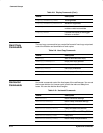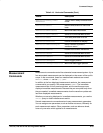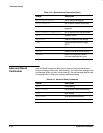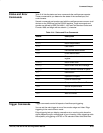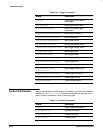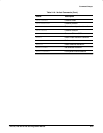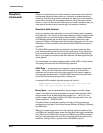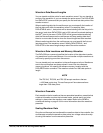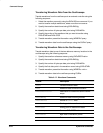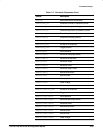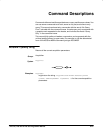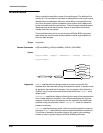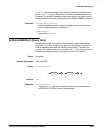
Command Groups
Syntax and Commands
2Ć22
Waveform commands let you transfer waveform data points to and from the
oscilloscope. Waveform data points are a collection of values that define a
waveform. One data value usually represents one data point in the waveform
record. When working with enveloped waveforms, each data value is either
the min or max of a min/max pair. Before you can transfer waveform data, you
must specify the data format, record length, and waveform locations.
Waveform Data Formats
Acquired waveform data uses either one or two 8Ćbit data bytes to represent
each data point. The number of bytes used depends on the acquisition mode
specified when you acquired the data. Data acquired in SAMple, ENVelope,
or PEAKdetect modes use one 8Ćbit byte per waveform data point; data
acquired in HIRes or AVErage modes use two 8Ćbit bytes per point. For more
information on the acquisition modes see the ACQuire:MODe command on
page 2Ć28.
The DATa:WIDth command lets you specify the number of bytes per data
point when transferring data to and from the oscilloscope. If you specify two
bytes for data that uses only one, the least significant byte will be filled with
zeros; if you specify one byte for data that uses two, the least significant byte
will be ignored.
The oscilloscope can transfer waveform data in either ASCII or binary format.
You specify the format with the DATa:ENCdg command.
ASCII Data Ċ is represented by single byte, signed integer values in the
range -128 to 127. Each data point value consists of up to three ASCII
characters for the value and one for the minus sign if the value is negative.
Commas separate data points. The DATa:WIDth command is ignored when
using ASCII format since the byte width is always one.
An example ASCII waveform data string may look like this:
CURVE<space>–110,–109,–110,–110,–109,–107,–109,–107,
–106,–105,–103,–100,–97,–90,–84,–80
Binary Data Ċ can be represented by signed integer or positive integer
values. The range of the values depends on the byte width specified. When
the byte width is one, signed integer data ranges from -128 to 127, and
positive integer values range from 0 to 255. When the byte width is two, the
values range from -32768 to 32767.
The defined binary formats also specify the order in which the bytes are
transferred giving a total of four binary formats: RIBinary, RPBinary, SRIbinary,
and SRPbinary.
RIBinary is signed integer where the most significant byte is transferred first,
and RPBinary is positive integer where the most significant byte is transferred
first. SRIbinary and SRPbinary correspond to RIBinary and RPBinary respecĆ
tively but use a swapped byte order where the least significant byte is transĆ
ferred first. The byte order is ignored when DATa:WIDth is set to 1.
Waveform
Commands



